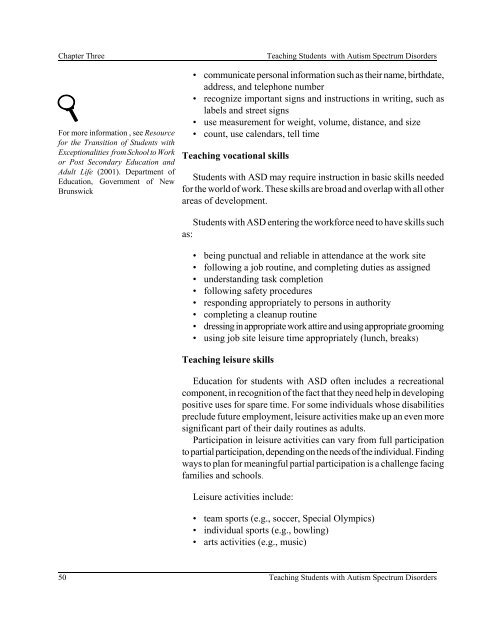Teaching Students with Autism Spectrum Disorders
Teaching Students with Autism Spectrum Disorders
Teaching Students with Autism Spectrum Disorders
You also want an ePaper? Increase the reach of your titles
YUMPU automatically turns print PDFs into web optimized ePapers that Google loves.
Chapter Three <strong>Teaching</strong> <strong>Students</strong> <strong>with</strong> <strong>Autism</strong> <strong>Spectrum</strong> <strong>Disorders</strong><br />
For more information , see Resource<br />
for the Transition of <strong>Students</strong> <strong>with</strong><br />
Exceptionalities from School to Work<br />
or Post Secondary Education and<br />
Adult Life (2001). Department of<br />
Education, Government of New<br />
Brunswick<br />
• communicate personal information such as their name, birthdate,<br />
address, and telephone number<br />
• recognize important signs and instructions in writing, such as<br />
labels and street signs<br />
• use measurement for weight, volume, distance, and size<br />
• count, use calendars, tell time<br />
<strong>Teaching</strong> vocational skills<br />
<strong>Students</strong> <strong>with</strong> ASD may require instruction in basic skills needed<br />
for the world of work. These skills are broad and overlap <strong>with</strong> all other<br />
areas of development.<br />
<strong>Students</strong> <strong>with</strong> ASD entering the workforce need to have skills such<br />
as:<br />
• being punctual and reliable in attendance at the work site<br />
• following a job routine, and completing duties as assigned<br />
• understanding task completion<br />
• following safety procedures<br />
• responding appropriately to persons in authority<br />
• completing a cleanup routine<br />
• dressing in appropriate work attire and using appropriate grooming<br />
• using job site leisure time appropriately (lunch, breaks)<br />
<strong>Teaching</strong> leisure skills<br />
Education for students <strong>with</strong> ASD often includes a recreational<br />
component, in recognition of the fact that they need help in developing<br />
positive uses for spare time. For some individuals whose disabilities<br />
preclude future employment, leisure activities make up an even more<br />
significant part of their daily routines as adults.<br />
Participation in leisure activities can vary from full participation<br />
to partial participation, depending on the needs of the individual. Finding<br />
ways to plan for meaningful partial participation is a challenge facing<br />
families and schools.<br />
Leisure activities include:<br />
• team sports (e.g., soccer, Special Olympics)<br />
• individual sports (e.g., bowling)<br />
• arts activities (e.g., music)<br />
50 <strong>Teaching</strong> <strong>Students</strong> <strong>with</strong> <strong>Autism</strong> <strong>Spectrum</strong> <strong>Disorders</strong>

















